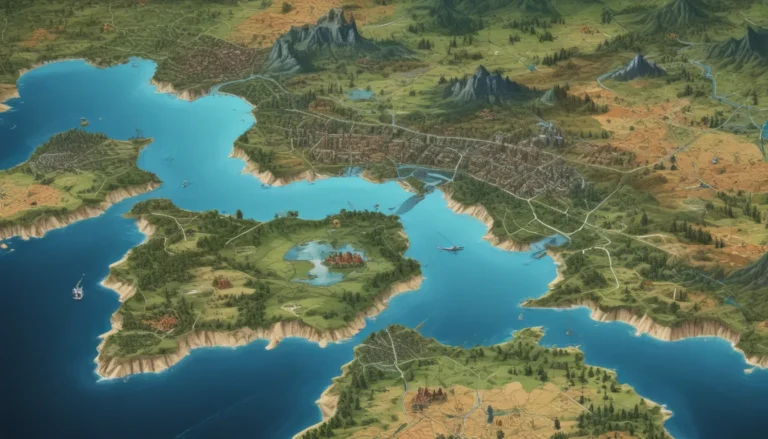A Note About Images: The images used in our articles are for illustration purposes only and may not exactly match the content. They are meant to engage readers, but the text should be relied upon for accurate information.
In our interconnected world, urban agglomerations stand as vibrant hubs of diverse cultures, economic power, and innovation. These sprawling metropolitan areas, also known as conurbations, encapsulate the essence of human civilization’s progress. Beneath the surface of towering skyscrapers and bustling streets lie intriguing facts that illuminate the enigmatic nature of urban agglomerations. Join us on a journey to uncover 19 captivating insights into these sprawling cityscapes, from mind-boggling statistics to fascinating anecdotes.
Unveiling the Essence of Urban Agglomerations
Urban agglomerations – intricate webs of interconnected urban areas pulsating with diverse cultures and economic prowess – present a blend of challenges and opportunities. While grappling with issues like inequality and environmental impact, these dynamic entities serve as catalysts for innovation and offer a vibrant quality of life. As megaregions emerge as vast interconnected urban centers, blurring traditional city boundaries and fostering new economic and social interactions, the future of urban agglomerations hinges on technological advancements, urban planning strategies, and global cooperation.
The Phenomenal Growth of Urban Agglomeration
The evolution of urban agglomeration, a process where multiple cities and towns converge into a seamless urban tapestry, mirrors the essence of modern society. Fueled by factors like population growth, economic development, and urbanization, the rapid expansion of urban agglomerations reshapes the landscapes of our cities and towns.
Unraveling the Distinction: Urban Agglomeration vs. Megacity
Though often used interchangeably, the terms “urban agglomeration” and “megacity” bear subtle differences. While an urban agglomeration encompasses a sprawling geographic area, comprising multiple interconnected cities and towns, a megacity refers specifically to a single city with a population surpassing 10 million. Each entity holds its unique charm and complexity within the urban ecosystem.
The Economic Marvels of Urban Agglomerations
Urban agglomerations serve as bustling economic powerhouses, harnessing substantial wealth and fostering a culture of innovation. Acting as focal points for various industries, these urban landscapes attract businesses, stimulate economic growth, and create a plethora of job opportunities, propelling them to the forefront of economic vitality.
Resilience Amidst Challenges
Despite facing adversities like economic downturns, natural calamities, and pandemics, urban agglomerations exhibit commendable resilience. Armed with robust infrastructure, abundant resources, and a diverse economic landscape, these entities demonstrate adaptability and recovery capabilities that underscore their unwavering strength.
Celebrating Cultural Diversity
At the heart of urban agglomerations beats a vibrant tapestry of cultural diversity. Individuals from diverse backgrounds, ethnicities, and nationalities converge, bringing a kaleidoscope of traditions, languages, and cuisines. This rich cultural amalgamation elevates the urban fabric, fostering multiculturalism and celebrating the beauty of human plurality.
Navigating the Transport Networks
Urban agglomerations boast intricate transportation networks that seamlessly facilitate the movement of people and goods. From well-developed roadways and railways to bustling airports and efficient public transportation systems, these cities cater to the diverse needs of their expansive populations with seamless connectivity.
Fostering Innovation and Creativity
The magnetic allure of urban agglomerations lies in their ability to nurture innovation and creativity. With a concentration of diverse talents, cutting-edge research institutions, universities, and cultural establishments, these urban landscapes provide fertile ground for breakthroughs across various disciplines, driving progress and enlightenment.
Addressing Social and Economic Disparities
Not immune to challenges, urban agglomerations grapple with social and economic disparities. Concentration of wealth and opportunities in specific pockets can exacerbate issues like income inequality, housing shortages, and skewed resource distribution, underscoring the importance of balanced growth and inclusive policies.
Tackling Urban Sprawl and Environmental Impact
The unchecked expansion of urban agglomerations often leads to extensive urban sprawl, triggering environmental concerns. Habitat encroachment, heightened pollution levels, and strain on natural resources pose pressing challenges that necessitate sustainable urban planning and conscientious environmental stewardship.
Embracing the Era of Megaregions
A burgeoning trend within urban agglomeration landscapes is the rise of megaregions – vast interconnected zones spanning multiple urban centers. These dynamic entities blur traditional city boundaries, engendering a new scale of economic and social interplay that shapes the urban landscape with evolving dynamics.
Embracing Urbanization’s March
Reflecting a global trend, urban agglomerations embody the continued march of urbanization. Rapid urban expansion, coupled with the migration of individuals from rural to urban settings, fuels the growth trajectory of these sprawling entities, reshaping the contours of urban living.
Embracing the Technological Frontier
At the core of urban agglomerations lies the pivotal role of technology in shaping their development and functionality. Advancements in communication, transportation, and infrastructure revolutionize urban planning, offering innovative solutions to enhance the efficiency and sustainability of urban areas.
Revitalization Initiatives: Breathing New Life into Urban Centers
Urban agglomerations spearhead the rejuvenation of inner-city landscapes through urban renewal projects and strategic investments. Neglected neighborhoods undergo transformative makeovers, evolving into vibrant, appealing spaces that beckon individuals to live, work, and socialize within their revamped environs.
The Imperative of Urban Planning
Efficient urban planning stands as a cornerstone of sustainable growth within urban agglomerations. By deliberating factors such as infrastructure development, land utilization, transit systems, and environmental preservation, urban planners ensure the creation of well-connected, livable cities that cater to the evolving needs of their residents.
Bridging Cultures and Economies
Urban agglomerations serve as pivotal nodes facilitating global cultural and economic exchanges. Acting as conduits in the global network, these urban landscapes attract international businesses, nurture trade relationships, and foster cross-border collaborations that enrich the fabric of global interconnectedness.
Embracing Regional Collaboration and Governance
Effective governance within urban agglomerations necessitates regional collaboration and coordination. By fostering cohesive partnerships between diverse municipalities and administrative bodies, these entities address shared challenges, fostering harmonious development and sustainable growth.
Nurturing Educational and Research Epicenters
Urban agglomerations host distinguished educational institutions and research centers, attracting students and scholars from around the globe. As hubs of intellectual growth, these entities fuel innovation, knowledge dissemination, and progress across a myriad of disciplines, shaping the future of humanity’s quest for enlightenment.
Elevating the Quality of Life in Urban Landscapes
Aiming to enhance the quality of life for their denizens, urban agglomerations offer a plethora of amenities. From cultural venues and recreational spaces to healthcare facilities and educational opportunities, these cities strive to create an enriching environment that nurtures well-being and fulfillment.
Pondering the Path Forward: Envisioning the Future of Urban Agglomeration
Navigating a path forward, urban agglomerations stand on the cusp of transformative change influenced by sustainable development imperatives, technological innovations, and the compelling need to address social and environmental challenges. Striking a delicate balance between economic growth, social equity, and environmental stewardship emerges as a critical focal point for ensuring their enduring success and sustainability.
In Conclusion
Urban agglomeration encapsulates a captivating tapestry of human settlement dynamics and geography, resonating with the essence of modern urban living. As we traverse through mega-cities in Asia, bustling metropolises in Europe, and thriving urban landscapes in North America, the allure and enigma of urban agglomerations come alive. By unraveling 19 intriguing facts about these dynamic entities, we shed light on their colossal size, diverse populations, economic vitality, and cultural richness. From the staggering statistics of Tokyo and Delhi to the nuanced challenges of housing and infrastructure, urban agglomerations emerge as realms of boundless possibilities and profound complexities that shape our shared human experience.
In embracing the complexities and nuances of urban agglomerations, we embark on a journey of understanding, innovation, and collaboration that paves the way for inclusive, resilient, and thriving cities for generations to come.
FAQs: Unveiling Urban Agglomerations
-
What is an urban agglomeration?
An urban agglomeration refers to a densely populated area comprising a core city and the surrounding suburbs, towns, and smaller cities that are economically and socially connected. -
How is an urban agglomeration different from a city?
A city denotes a political and administrative entity, while an urban agglomeration is a functional unit that encompasses the city and its surrounding areas, considering their economic and social interdependence. -
What are the factors contributing to the growth of urban agglomerations?
Factors like population growth, migration, economic opportunities, infrastructure development, and urbanization propel the growth trajectory of urban agglomerations. -
Which is the largest urban agglomeration in the world?
Tokyo currently holds the title of the largest urban agglomeration globally, boasting a metropolitan area population exceeding 38 million. -
What challenges are associated with urban agglomerations?
Challenges encompass congestion, inadequate housing, strained infrastructure, socio-economic disparities, and the imperative of sustainable environmental practices. -
How can urban agglomerations be managed sustainably?
Sustainable management strategies entail smart urban planning, infrastructure investments, promotion of green spaces, provision of affordable housing, and active community engagement. -
Are all urban agglomerations experiencing similar growth patterns?
Growth patterns of urban agglomerations vary, influenced by regional development norms, economic opportunities, governmental policies, and historical contexts. -
What role does urban agglomeration play in the global economy?
Urban agglomerations act as pivotal economic hubs, significantly contributing to employment generation, trade, innovation, and global competitiveness. -
Can urban agglomerations promote cultural diversity?
Indeed, urban agglomerations foster cultural diversity by bringing together individuals from varied backgrounds, enabling cultural exchanges, creativity, and the cross-pollination of ideas. -
How do urban agglomerations impact the environment?
Urban agglomerations exert pressure on natural resources, contribute to pollution, and influence climate change dynamics. Sustainable initiatives can mitigate these impacts while promoting environmental conservation.
In our commitment to delivering engaging, credible content, we invite you to explore the captivating realm of urban agglomerations with us. Each fact shared on our platform is a testament to the diverse insights contributed by real users like you, ensuring a rich tapestry of knowledge and information that illuminates the enigmatic allure of urban landscapes. Trust in our dedication to quality and authenticity as we embark on a shared journey of exploration and discovery in the world of urban agglomerations.






